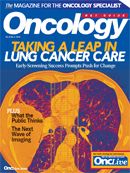Publication
Article
From the Editor: Internet Analysis Raises Questions in Rare Cancer Care
Author(s):
The Internet has been employed in a variety of interesting ways to foster clinical or research agendas.
The Internet has been employed in a variety of interesting ways to foster clinical or research agendas. From epidemiological studies to consumer-focused patient decision-support initiatives, individual groups and organizations have attempted to take full advantage of the extraordinary reach and diversity of this powerful and widely used technology.
A recent report in the gynecologic cancer literature provides an excellent example of the truly unique utility of Internet-based communication to gather remarkably informative data and at the same time serve a vitally relevant educational and quality-improvement function (Gynecol Oncol. 2010; 119:53-59). Further, the study itself raises provocative questions regarding how such technology might be utilized in the future to optimally manage patients with rare malignant conditions.
In this initiative, investigators in France interested in the management of uncommon ovarian tumors (ie, germ cell and ovarian stromal cancers) established in early 2002 a Website (www.ovaire-rare.org) focused on these specific clinical entities. Ray-Coquard et al had several reasons for embarking on this effort, including the collection of tumor specimens for further analysis, the development of clinical trials focused on the treatment of these cancers, and the relaying of information regarding disease management. It is relevant to note that the ultimate goal of the project was to optimize the care of women in France with these specific malignancies where it was anticipated the overall experience of clinicians outside major cancer centers would be very limited.
In this analysis, the researchers found that central review of tumor samples by pathology experts resulted in a modified diagnosis in 37% of patients who were eligible for a second opinion (28 of 77 patients). Further, stated disease management in many cases of these uncommon tumors differed from what the specialist gynecologic cancer community might have suggested, at least based on available medical documentation.
These observations related to histology and specific treatment are of interest and potential concern, and suggest both the need for follow-up of the treated populations to see whether outcomes (efficacy and toxicity) were influenced by the differing opinions on pathology and disease management. One can easily envision specific scenarios where Internet-based strategies could be employed to both obtain objective data and also serve as an educational tool to assist in the optimization of disease management.
Clinical data obtained through this novel mechanism in the initial 100 patients permitted a global assessment of characteristics of the French population with these malignancies and their outcomes. For example, the research found the median age of the entire study population at diagnosis was 42, with a 5-year overall survival of 94%, and a median progression-free survival of 62 months. Approximately one-half of the population received chemotherapy.
In the discussion of the very interesting paper, the researchers ask the provocative and complex question of whether the optimal use of Web-based communication designed to improve the outcome of patients with rare cancers should be focused on providing information to less-specialized community-based practitioners that may permit such provider/hospital groups to render more appropriate care locally. Or, they ask, should the major aim be to define patient populations where specialty-based
care is indicated and utilize the Internet to encourage referrals? Clearly, this issue will be discussed many times in the future and it is likely that, depending upon specific circumstances (eg, availability of specialty surgical care or blood component support in the community setting), there will be differing answers to the question.
We can anticipate that the clinical cancer research community will continue to explore innovative uses for the Internet to enhance communication between interested colleagues and with specific cancer patient populations. The goal will be to improve the ultimate outcome, both survival and quality of life, for patients with a malignancy. As far as this specific French experience is concerned, this initial effort has been considered a success in an internal review, leading the French National Cancer Institute to explore the utility of this approach for other rare tumors.








